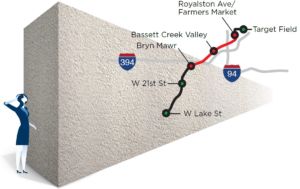Read it and Grin: Minneapolis officials call for Environmental Review of SWLRT Crash Wall
The week ended with yet another story about Southwest Light Rail (SWLRT) that raises doubt about the Met Council’s ability to keep this project on track.
In mid-August, the Met Council made public an agreement with the BNSF Railroad to build a “crash” wall between the freight line and SWLRT from near-downtown stations and the Bryn Mawr neighborhood station (that area off to the right as you head west on 394). The proposed reinforced concrete wall, 1.4 miles long, 10 feet high and 3 feet thick, is intended to prevent loss of life and property destruction when there is a derailment of freight.

While Rep. Frank Hornstein and Sen. Scott Dibble, and several Minneapolis officials expressed outrage and frustration with both the lack of notice and process back in August, it was not until last this week that Mayor Betsy Hodges, several (not all) city council members and Hornstein and Dibble, sent a formal letter to the Met Council calling for a supplemental environmental impact study, or EIS.
That EIS could further delay the already delayed SWLRT for months. The Council just rejected all four civil construction bids and has gone back to the drawing board on the request for proposal to find cost-saving measures, thus pushing out the date when it can ask the feds for matching funds.
None of these elected officials, all from the Governor’s party, have helped to stop SWLRT from getting this far. Sen. Scott Dibble serves on the transportation committee (he used to chair it). What has he done to stop this train? Frank Hornstein likes to complain about the freight lines; but they have been there since the 19th century, serving farmers and manufacturing across the state. Why not focus on stopping SWLRT?
It is fair to ask, if SWLRT is built as planned, would it be better not to have this crash wall? Are officials making a stink now because this wall will be an ugly hard-to-ignore monument to their inability to do the right thing?
It does not sound like the (unelected) Met Council Chair is too worried about getting around silly elected officials. According to the Star Tribune:
In response, Tchourumoff said in a statement that Southwest’s planners will work with the city and the community “on the aesthetic design of the wall.”
She said the community outreach plan includes open houses, checking with neighborhoods such as Bryn Mawr, and consulting with the project’s Minneapolis landscape advisory group.
“The council shares the priority of protecting our environment,” Tchourumoff said. “We will of course comply with all state and federal laws to ensure adequate protection of our environmental resources, and intend to do all appropriate and necessary environmental work related to this wall.”
On other words, the Met Council plans to build the wall and plant some nice shrubbery to appease local officials and residents.
Look on the bright side Minneapolis: the wall could be passed off as an expansion of the nearby Walker Art Museum’s Sculpture Garden. Think of the wall as a giant canvas. The Walker could provide spray paint to aspiring local artists to encourage self-expression, sponsoring an annual “We Love Our Wall” contest. Imagine how much the residents of Bryn Mawr will enjoy looking at their art. The Met Council could even save some bucks here; with all the graffiti, surely the train stations will not need any more “public art.”
On the serious side, the BNSF crash wall raises an important question: since SWLRT would co-locate with another freight line running through densely populated Hopkins and St. Louis Park, why is a crash wall not planned there? What happens when there is a derailment there?
The reason to read the entire two-page letter can only be summed up as “schadenfreude” or read it and grin.
The Met Council has been leveraging its massive scope of authority to inflict its worship of all things leftist on the metro area for years—shoving its muscular re-visioning of where and how we should live down our throats, while ignoring the people we elect at the city, county and state level.
One can take gleeful pleasure from reading Mayor Betsy Hodges and other elected representatives complain about the Council’s lack of respect for local control and governance. Indeed! The cherry on top is that if the city succeeds in getting that supplemental EIS, or if it (or the state) passes land use laws that interfere with plans for SWLRT, Minnesota will witness a left-on-left slugfest for a change.
I am getting more optimistic about the Left’s willingness to help the Center rein in and reform the Met Council.